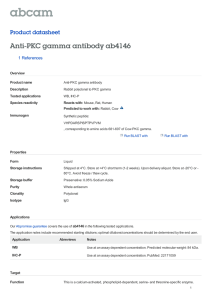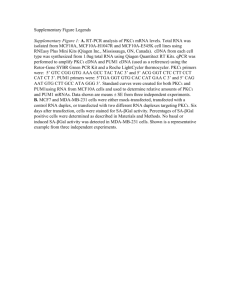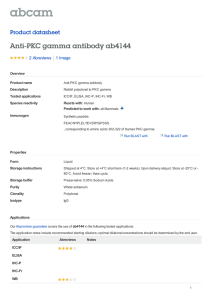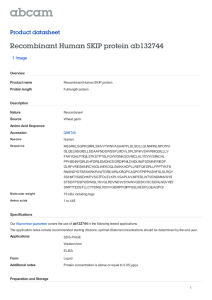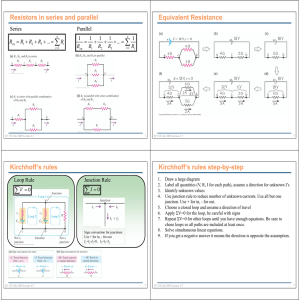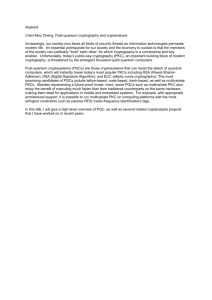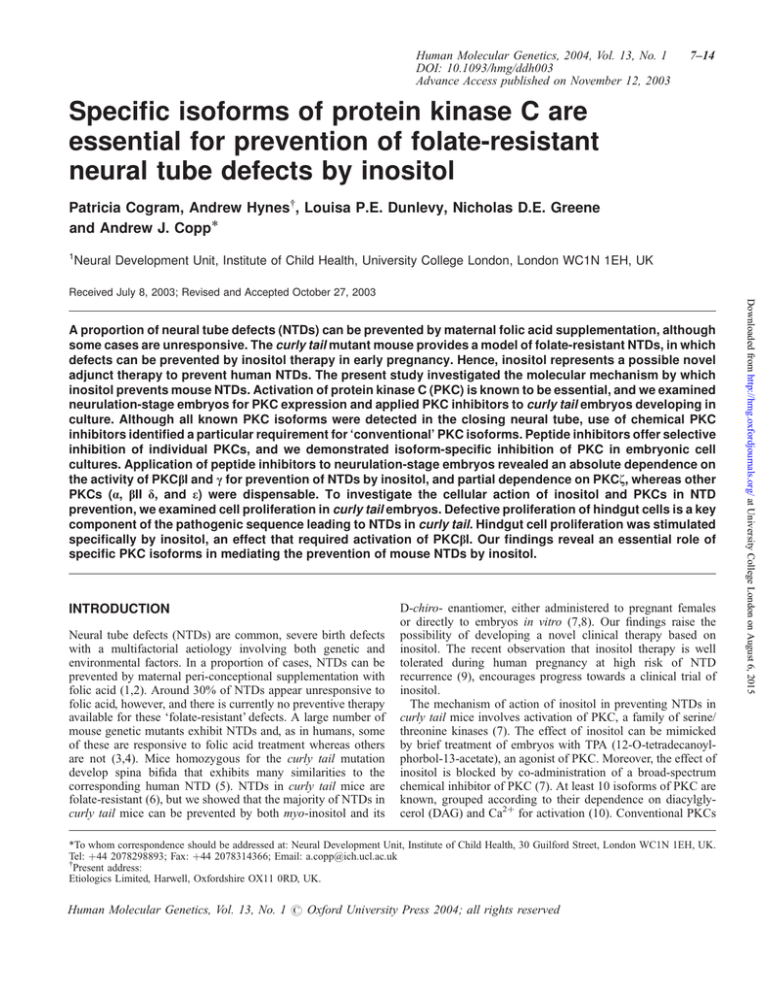
Human Molecular Genetics, 2004, Vol. 13, No. 1
DOI: 10.1093/hmg/ddh003
Advance Access published on November 12, 2003
7–14
Specific isoforms of protein kinase C are
essential for prevention of folate-resistant
neural tube defects by inositol
Patricia Cogram, Andrew Hynes{, Louisa P.E. Dunlevy, Nicholas D.E. Greene
and Andrew J. Copp*
1
Neural Development Unit, Institute of Child Health, University College London, London WC1N 1EH, UK
Received July 8, 2003; Revised and Accepted October 27, 2003
INTRODUCTION
Neural tube defects (NTDs) are common, severe birth defects
with a multifactorial aetiology involving both genetic and
environmental factors. In a proportion of cases, NTDs can be
prevented by maternal peri-conceptional supplementation with
folic acid (1,2). Around 30% of NTDs appear unresponsive to
folic acid, however, and there is currently no preventive therapy
available for these ‘folate-resistant’ defects. A large number of
mouse genetic mutants exhibit NTDs and, as in humans, some
of these are responsive to folic acid treatment whereas others
are not (3,4). Mice homozygous for the curly tail mutation
develop spina bifida that exhibits many similarities to the
corresponding human NTD (5). NTDs in curly tail mice are
folate-resistant (6), but we showed that the majority of NTDs in
curly tail mice can be prevented by both myo-inositol and its
D-chiro- enantiomer, either administered to pregnant females
or directly to embryos in vitro (7,8). Our findings raise the
possibility of developing a novel clinical therapy based on
inositol. The recent observation that inositol therapy is well
tolerated during human pregnancy at high risk of NTD
recurrence (9), encourages progress towards a clinical trial of
inositol.
The mechanism of action of inositol in preventing NTDs in
curly tail mice involves activation of PKC, a family of serine/
threonine kinases (7). The effect of inositol can be mimicked
by brief treatment of embryos with TPA (12-O-tetradecanoylphorbol-13-acetate), an agonist of PKC. Moreover, the effect of
inositol is blocked by co-administration of a broad-spectrum
chemical inhibitor of PKC (7). At least 10 isoforms of PKC are
known, grouped according to their dependence on diacylglycerol (DAG) and Ca2þ for activation (10). Conventional PKCs
*To whom correspondence should be addressed at: Neural Development Unit, Institute of Child Health, 30 Guilford Street, London WC1N 1EH, UK.
Tel: þ44 2078298893; Fax: þ44 2078314366; Email: a.copp@ich.ucl.ac.uk
{
Present address:
Etiologics Limited, Harwell, Oxfordshire OX11 0RD, UK.
Human Molecular Genetics, Vol. 13, No. 1 # Oxford University Press 2004; all rights reserved
Downloaded from http://hmg.oxfordjournals.org/ at University College London on August 6, 2015
A proportion of neural tube defects (NTDs) can be prevented by maternal folic acid supplementation, although
some cases are unresponsive. The curly tail mutant mouse provides a model of folate-resistant NTDs, in which
defects can be prevented by inositol therapy in early pregnancy. Hence, inositol represents a possible novel
adjunct therapy to prevent human NTDs. The present study investigated the molecular mechanism by which
inositol prevents mouse NTDs. Activation of protein kinase C (PKC) is known to be essential, and we examined
neurulation-stage embryos for PKC expression and applied PKC inhibitors to curly tail embryos developing in
culture. Although all known PKC isoforms were detected in the closing neural tube, use of chemical PKC
inhibitors identified a particular requirement for ‘conventional’ PKC isoforms. Peptide inhibitors offer selective
inhibition of individual PKCs, and we demonstrated isoform-specific inhibition of PKC in embryonic cell
cultures. Application of peptide inhibitors to neurulation-stage embryos revealed an absolute dependence on
the activity of PKCbI and c for prevention of NTDs by inositol, and partial dependence on PKCf, whereas other
PKCs (a, bII d, and e) were dispensable. To investigate the cellular action of inositol and PKCs in NTD
prevention, we examined cell proliferation in curly tail embryos. Defective proliferation of hindgut cells is a key
component of the pathogenic sequence leading to NTDs in curly tail. Hindgut cell proliferation was stimulated
specifically by inositol, an effect that required activation of PKCbI. Our findings reveal an essential role of
specific PKC isoforms in mediating the prevention of mouse NTDs by inositol.
8
Human Molecular Genetics, 2004, Vol. 13, No. 1
Figure 1. Developmental regulation of PKC isoform expression in mouse
embryos from E9.5 to E16.5. Sub-cellular protein fractions of whole embryo
homogenates were western blotted using isoform-specific anti-PKC antibodies.
PKC isoforms exhibit varying patterns of developmental regulation ranging from
limited expression in only the C fraction, at only the most advanced developmental stages (PKCa and b) to constitutive expression in all three fractions, throughout the developmental period studied (PKCZ, z, l and m). Abbreviations: A,
b-actin control; C, cytoplasmic fraction; Co, Coomassie Blue stained loading
control; MBr, mouse brain standard; Ps, soluble pelleted fraction (membrane
associated); Pi, insoluble pelleted fraction. Experiment performed on two
occasions with same result.
RESULTS
PKC isoform expression during mouse embryogenesis
In order to identify the isoforms that might play a role in
prevention of NTD, we initially determined which PKC
isoforms are expressed in mouse embryos undergoing
organogenesis (E9.5 to E16.5). Western blot analysis of
cytoplasmic (C), membrane-associated (Ps) and insoluble (Pi)
fractions of embryonic cell extracts indicated the degree to
which PKC isoforms are activated (i.e. associated with
membrane or insoluble cellular compartments). All PKC
isoforms could be detected, but their relative abundance varied
with stage and cellular fraction (Fig. 1). cPKCs (a, b, g) were
weak or undetectable in the cytoplasmic fraction at E9.5 and
E10.5, although expression increased from E11.5 onwards.
Among the cPKCs, only PKCg was present in the Ps fraction
from E11.5 and in the Pi fraction at the latest stages. nPKCs
(d, e, y, Z) were expressed throughout the developmental
period in both C and Ps fractions, whereas expression in the Pi
fraction was more variable. aPKCs (l, z and the related PKCm)
were abundant from E9.5 onwards in all cellular fractions, with
a fairly constant level of expression. All PKC isoforms were
also detected in mutant curly tail embryos with no consistent
differences in abundance compared with non-mutant CD1 mice
(data not shown). Hence, the DAG-responsive cPKCs and
nPKCs, which are likely to mediate the normalizing effect of
inositol (6), exhibit evidence of stage-dependent activation
unlike the aPKCs which appear ubiquitous and constitutively
activated, as also described in other systems (12).
Western blot analysis was insufficiently sensitive to detect
PKC isoform expression in specific embryonic regions, such as
the posterior neuropore (PNP), the site of spinal neurulation
(13). We performed immunohistochemistry on histological
sections through the PNP region, and detected expression of
PKCs a, bI, bII, g and e in the closing neural tube, hindgut,
notochord and presomitic mesoderm, at both E9.5 and E10.5
(Fig. 2). We conclude that although cPKCs, in particular, are
variably expressed in whole neurulation-stage embryos by
immunoblotting, they can be detected in all tissues of the PNP
region by immunohistochemistry and, therefore, are candidates
for a role in mediating the preventive effect of inositol on
NTDs. Immunostaining was not carried out for the remaining
isoforms as they were clearly detectable by western blot (Fig. 1).
Chemical PKC inhibitors block the protective effect
of inositol on NTDs
We used PKC inhibitors to block the effect of inositol on neural
tube closure. Curly tail embryos were cultured from E9.5 to
E10.5, and the length of unclosed neural folds at the PNP was
then measured to indicate predisposition to spina bifida (13).
Embryos exposed to PBS (vehicle) alone had enlarged PNPs
(Fig. 3A), reflecting the in vivo development of spinal NTDs
by 50–60% of curly tail embryos (5), whereas treatment with
myo-inositol decreased PNP length significantly (first grey bar,
Fig. 3A), to a value characteristic of normally developing
embryos (5). Hence, inositol normalizes PNP closure in vitro,
confirming previous findings (7,8). Curly tail embryos were
exposed in culture to chemical inhibitors that block different
combinations of PKC isoforms. Bisindolylmaleimide I (BisI)
inhibits PKCa, bI, bII, g and e (14), Go6976 inhibits solely
cPKCs (15), HBDDE inhibits PKCa and g in vitro (16) and
LY294002 is an inhibitor of phosphatidylinositol-3-kinase (17),
an activator of PKCz (18). When added alone, none of the
inhibitors significantly altered PNP length (white bars, Fig. 3A).
Moreover, BisV, an inactive control, did not prevent the
reduction in PNP length caused by co-administration of inositol
(second grey bar, Fig. 3A). In contrast, BisI, Go6976, HBDDE
and LY294002 all partially blocked the normalizing effect of
inositol, such that PNP length was reduced to a significantly
lesser degree than in the presence of inositol alone (black bars,
Fig. 3A). Hence, use of chemical inhibitors highlights the
Downloaded from http://hmg.oxfordjournals.org/ at University College London on August 6, 2015
(cPKCs; a, bI, bII, g) require DAG and Ca2þ, novel PKCs
(nPKCs; d, e, Z, y) are DAG-sensitive but Ca2þ-insensitive,
and atypical PKCs (aPKCs; z, l and the related PKCm) are
activated by neither DAG or Ca2þ (10).
To elucidate the molecular mechanism by which inositol
normalizes neural tube closure, we determined which of the
PKC isoforms mediate this effect. All known PKC isoforms
could be detected during mouse neural tube closure, but culture
of intact curly tail embryos in the presence of isoform-specific
PKC inhibitors identified PKCbI and g as essential for the
normalizing action of inositol. Other PKC isoforms were not
required. At the cellular level, inositol treatment was found to
correct the deficit of cell proliferation that underlies NTD
development in curly tail embryos (11), an effect that is
blocked by inhibition of PKCbI. Moreover, treatment of
cultured cells with either the PKC activator TPA or inositol
itself, could induce translocation of PKC isoforms, including
PKCbI and g to the nucleus. We conclude that PKCbI and g are
essential components of the molecular mechanism underlying
the preventive effect of inositol on mouse NTDs.
Human Molecular Genetics, 2004, Vol. 13, No. 1
potential importance of PKCa, b, g, e and z in mediating NTD
prevention by inositol.
Peptide inhibitors identify a critical role for PKCbI,
c and f in the inositol effect
Because of the relatively broad spectrum activity of chemical
PKC inhibitors, we next applied isoform-specific peptide PKC
inhibitors to cultured curly tail embryos, to more precisely
define the PKC isoform requirement for the inositol effect.
Each peptide inhibitor was designed to the amino acid
Figure 3. Normalization of spinal neural tube closure by inositol in curly tail
embryos is abrogated by inhibition of specific PKC isoforms. (A) Chemical
and (B) isoform-specific peptide PKC inhibitors were applied to curly tail
mouse embryos cultured from E9.5 for 24 h, followed by measurement of
posterior neuropore (PNP) length, an indicator of predisposition to spinal
NTD (13). White bars: PNP length of embryos exposed to PKC inhibitors
in the absence of inositol; grey bars: PNP length of embryos exposed to
PKC inhibitors in the presence of inositol; black bars: PNP length in the presence of PKC inhibitor plus inositol as a % of the value in the presence of
PKC inhibitor alone (right axis). (A) Inositol significantly reduces PNP length
in the absence of inhibitor (PBS; P < 0.001) and in the presence of inactive
BisV (P < 0.002), whereas the inositol effect is abrogated in the presence of
chemical inhibitors BisI, Go6976, HBDDE and LY294002 (P > 0.05). (B)
Inositol significantly reduces PNP length in the absence of inhibitor (PBS;
P < 0.001) and in the presence of inactive peptide (Pept) or peptide inhibitors
to PKC a, bII, d (P < 0.005) and e (P < 0.05), whereas the inositol effect is
abrogated by inhibitors to PKCbI, g and z (P > 0.05). There is no effect on
PNP length of either chemical or peptide inhibitors in the absence of inositol
(analysis of variance, P > 0.05).
sequence corresponding to the isoform-specific RACK (receptor for activated C kinase) binding site on PKC. Inhibitors of
this type prevent PKC translocation and/or activation in an
isoform-specific manner (19,20). Peptide inhibitors were
coupled to a sequence derived from the Drosophila
Antennapedia homeodomain, ensuring cell permeability.
As with the chemical inhibitors, peptide PKC inhibitors
alone had no significant effect on PNP length. Moreover,
Downloaded from http://hmg.oxfordjournals.org/ at University College London on August 6, 2015
Figure 2. Ubiquitous expression of PKC isoforms during mouse spinal neurulation, detected by immunohistochemistry. Transverse histological sections
through the posterior neuropore region of curly tail mouse embryos at E9.5
(A, D, G, J, M) and E10.5 (B, E, H, K, N) stained with antibodies specific
for PKCa, bI, bII, g and e. All PKCs exhibit ubiquitous expression in the neural
plate, notochord, hindgut and presomitic mesoderm of the posterior neuropore
region. Sections of adult mouse cerebellum (C, F, I, L, O) provide a positive
control for the isoform-specific PKC antibodies: anti-PKCa, g and e stain only
Purkinje cells, whereas anti-PKCbI and bII stain only granule cells, as
described previously for the rat cerebellum (46). Abbreviations: G, granule
cells; H, hindgut; M, presomitic mesoderm; N, notochord; Np, neural plate;
P, Purkinje cells. Scale bar represents 20 mm.
9
10
Human Molecular Genetics, 2004, Vol. 13, No. 1
the normalizing effect of inositol on PNP length persisted in the
presence of inhibitors for PKCa, bII, d and e, as well as an
inactive peptide (Fig. 3B). Strikingly, however, the co-addition
with inositol of inhibitors for PKCbI or g largely abolished the
normalizing effect of inositol (black bars in Fig. 3B). Inhibition
of PKCz also partially blocked the normalizing action of
inositol. These findings are consistent with the results from use
of the chemical inhibitors, and indicate that the cPKCs, bI and
g, and additionally PKCz, are critical for mediating the
preventive effect of inositol.
Activation of PKC isoforms in embryonic mouse cells
is blocked by peptide inhibitors
Figure 4. Inhibition of PKC isoform translocation by peptide inhibitors in TPAtreated mouse embryonic cells. Immunocytochemistry using isoform-specific
antibodies to PKC (as in Fig. 2) in curly tail primary embryonic cell cultures.
Cells cultured for 18 h in growth medium containing 1% FCS were either fixed
with no additional treatment (‘serum starved’; A, D, G, J, M), exposed to
100 mM TPA for 10 min prior to fixation (þTPA; B, E, H, K, N), or exposed
to 1 mM isoform-specific PKC inhibitor for 20 min and to TPA for 10 min prior
to fixation (TPA þ Inhib; C, F, I, L, O). PKCs are uniformly located in the
cytoplasm of serum starved cells whereas a 10 min treatment with TPA induces
translocation to the nucleus in all cases. Pre-treatment with isoform-specific
PKC inhibitors prevents TPA-induced translocation and all PKC isoforms exhibit cytoplasmic staining. Inset in (O) shows same field stained with DAPI to
demonstrate nuclei. Scale bar represents 20 mm.
Embryonic cell proliferation is stimulated by inositol,
in a PKCbI-sensitive manner
Delayed closure of the PNP in curly tail embryos results from a
reduced rate of cell proliferation, specifically in the embryonic
hindgut, within the caudal region (3,11,21,22). The resulting
proliferation imbalance causes ventral curvature of the caudal
region, counteracting the apposition of the neural folds, and
leading to spina bifida (23,24). The effect of inositol on cell
proliferation was examined by immunohistochemistry for
PCNA (proliferating cell nuclear antigen) and phospho-histone
H3, markers of S-phase and M-phase of the cell cycle
respectively. A significant stimulatory effect of inositol on
Downloaded from http://hmg.oxfordjournals.org/ at University College London on August 6, 2015
One possible explanation for the apparently isoform-specific
PKC requirement for inositol action is that bI, g and z are the
only isoforms whose activation is blocked by peptide inhibitors
in curly tail embryonic cells. To test this idea, primary
fibroblastic cell cultures, prepared from caudal regions of E9.5
curly tail embryos were serum-starved, and then treated with
the PKC agonist, TPA, in the presence or absence of peptide
PKC inhibitors. Prior to TPA treatment, each PKC isoform
exhibited cytoplasmic localization (Fig. 4A, D, G, J and M)
but, following TPA treatment, all isoforms translocated to the
nucleus (Fig. 4B, E, H, K and N), indicative of activation. In
every case, addition of the appropriate peptide inhibitor
blocked this TPA-induced translocation indicating that PKC
activation had been prevented (Fig. 4C, F, I, L and O). Closely
similar results were obtained with the mouse 3T3 cell line (data
not shown).
In view of the close relationship between PKCbI and its
alternatively spliced variant PKCbII, we tested whether
abrogation of the inositol effect by the PKCbI inhibitor might
have resulted from antagonism of both PKCbI and bII
activation. PKCbI translocated to the nucleus following TPA
stimulation, and this translocation was blocked by the bI
inhibitor, but not by the bII inhibitor (Fig. 5A–C). Conversely,
translocation of PKCbII was blocked by the bII inhibitor but
not the bI inhibitor (Fig. 5D–F). This finding confirms that the
peptide inhibitors of PKCbI and bII are indeed isoform-specific
and suggests separate roles for these splice variants. We
conclude that the requirement for specific PKC isoforms is
unlikely to reflect differential activity of the peptide inhibitors,
but may reflect a difference in participation of PKC isoforms in
the action of inositol in preventing mouse NTDs.
To determine whether the PKC stimulation observed after
TPA treatment also follows inositol administration, we studied
PKC localization after inositol treatment. Inositol treatment
was capable of inducing the translocation of PKCa from the
cytoplasm, as in serum-starved cells, to the nucleus (Fig. 5G
and H). Similarly, PKCbI and g, isoforms whose activity is
essential for prevention of NTD, were also found to exhibit
nuclear localization in inositol-treated but not in untreated cells
(data not shown). No difference in the localization of PKCz
could be detected after 6 h inositol treatment (50 mg/ml), but we
cannot rule out the possibility that PKCz is activated at a
different dose or at a different time point. This observation
suggests that PKCa, bI and g can be activated by inositol
treatment. However, PKCa is not required for prevention of
NTD whereas PKCbI and g are essential.
Human Molecular Genetics, 2004, Vol. 13, No. 1
the percentage of PCNA-positive (Fig. 6A) and histone
H3-positive (Fig. 6B) cells was detected in the hindgut,
whereas inositol treatment had no effect on either proliferation
marker in the neuroepithelium or notochord (Fig. 6A and B).
Co-administration of the PKCbI peptide inhibitor blocked the
stimulatory effect of inositol on hindgut proliferation, whereas
the PKCe inhibitor had no effect. Neither inhibitor significantly
altered proliferation in neuroepithelium or notochord. Hence,
inositol overcomes the genetically-determined defect of cell
proliferation in curly tail embryos, an effect that requires
activation of PKCbI.
DISCUSSION
Inositol normalizes neural tube closure in the spinal region of
curly tail mouse embryos destined to develop spina bifida (7),
whereas folic acid has no preventive effect (6). Brief treatment
with the PKC agonist TPA mimics the inositol effect, whereas
the PKC inhibitor BisI abrogates inositol-mediated prevention
(7). Here, we used other chemical PKC inhibitors, with
reportedly narrower spectra of action, and showed that these are
Figure 6. Inositol stimulates hindgut cell proliferation during NTD prevention,
an effect requiring activation of PKCbI but not PKCe. Cell proliferation
was measured in tissues of the posterior neuropore region of cultured curly
tail embryos by (A) PCNA labelling, a measure of cells in S-phase and (B)
phospho-histone H3 labelling, a marker of mitotic cells. Cell proliferation is
most rapid in neuroepithelium, less intense in hindgut endoderm and slowest
in notochord, as described previously (11). Inositol significantly stimulates
PCNA labelling (P < 0.005) and histone H3 labelling (P < 0.02) in hindgut
endoderm, whereas inositol has no significant effect on PCNA or histone H3
labelling in either neuroepithelium or notochord (P > 0.05). In hindgut endoderm, inhibition of PKCbI significantly reduces histone H3 labelling compared
with inositol alone (P < 0.05), whereas inhibition of PKCe has no significant
effect (P > 0.05). Blocking PKCbI or e has no significant effect on histone
H3 labelling in neuroepithelium or notochord (P > 0.05). No cells were positive
for histone H3 in the presence of inositol and the PKCbI inhibitor (Fig. 6B,
notochord data, bar 5). Labelling indices are mean SEM of at least 10
embryos per treatment.
also able to block the inositol effect. However, the precise
specificity of chemical PKC inhibitors may vary between cell
types. For example, HBDDE is specific for PKCa and g in vitro
(16), but acts on other molecular targets in cerebellar granule
neurons (25). This prompted the use of peptide PKC inhibitors
which were able to block the translocation of specific PKC
isoforms. Isoform-by-isoform analysis using these inhibitors
revealed a requirement for PKCbI, g and z, but not other PKCs
in the normalization of neural tube closure in curly tail
embryos.
Downloaded from http://hmg.oxfordjournals.org/ at University College London on August 6, 2015
Figure 5. Inositol stimulates PKC translocation, whereas peptide inhibitors to
PKCbI and bII exhibit isoform-specificity in blocking translocation. PKC
isoforms were localized by immunocytochemistry on primary cell cultures
established from curly tail mouse embryos. Serum starved cells exhibit
PKCbI and bII immunoreactivity in the cytoplasm. TPA-induced translocation
to the nucleus of PKCbI can be blocked by the bI inhibitor (C) but not by the
bII inhibitor (B). Conversely, translocation to the nucleus of PKCbII can be
blocked by the inhibitor to bII (E) but not by the inhibitor to bI (F).
Addition of 50 mg/ml myo-inositol to serum starved cells 6 h prior to fixation
induces translocation of PKCa to the nucleus (H) whereas PKCa is cytoplasmic in untreated cells (G). This effect of inositol is not unique to curly tail cells
as similar results were obtained in 3T3 cells. Scale bar represents 20 mm.
11
12
Human Molecular Genetics, 2004, Vol. 13, No. 1
Developmental regulation of PKC isoform expression
PKC isoforms and cell cycle regulation
We have demonstrated that inositol stimulates cell proliferation
in the hindgut of curly tail embryos, reversing the imbalance of
cell proliferation that is known to lead, via enhanced ventral
curvature of the caudal region, to delay or failure of PNP
closure (11,23,24,28). Moreover, PKCbI but not PKCe is
required for this stimulation of cell proliferation. PKCbI has
been previously associated with increased cell cycle entry.
Its over-expression leads to increased proliferation of aortic
endothelial cells, in contrast to PKCa which has an inhibitory
effect (29). Similarly, proliferation of vascular smooth muscle
cells is stimulated by PKCbI, through increased S-phase entry,
but inhibited by PKCbII, through extension of S-phase (30).
S-phase entry/progression has been suggested to be defective in
hindgut cells of curly tail embryos (11), raising the possibility
that activation of PKCbI may reverse this defect, leading to
‘rescue’ of the mutant phenotype. Interestingly, inositol
treatment of cells for 6 h resulted in nuclear translocation of
PKCbI and g in some cells, as observed for short-term
exposure to TPA. This nuclear localization suggests that a role
of PKCbI in cell cycle regulation is plausible. PKCa also
exhibits nuclear translocation in inositol-treated cells (both
curly tail and non-mutant), but does not play an essential role in
the prevention of NTD.
Molecular basis of the requirement for PKCf
and PI3-kinase
The normalizing effect of inositol on PNP closure was partially
blocked by inhibition of PKCz or PI3-kinase. The requirement
for PKCz may reflect a role in regulating other PKC isoforms
(31). PKCz is activated downstream of PI3-kinase (18), whose
activity in turn depends on availability of phosphatidylinositol
species. Hence, inositol administration may activate both
PI3-kinase and PKCz, by increasing flux through intracellular
phosphoinositide metabolism. Indeed, inhibition of the inositol
phosphate cycle by lithium blocks the preventive effect of
Is PKC implicated in the mechanism of
neural tube closure?
Several lines of evidence suggest that spinal neurulation per se
does not depend on PKC activation and that defective closure
in curly tail embryos is unlikely to result from an intrinsic
deficiency in specific PKC isoforms. First, exposure of curly
tail embryos to PKC inhibitors, in the absence of inositol, did
not affect PNP closure. Similar findings were obtained with
non-mutant CD1 embryos (data not shown). Second, there is no
difference in abundance of PKC isoforms between affected and
unaffected curly tail embryos (data not shown). Third, uptake
and incorporation of 3H-inositol occurs similarly in cultured
curly tail and non-mutant embryos, while inositol deficiency
in vitro does not increase the penetrance of spinal NTDs in
curly tail embryos (7). Finally, mice with targeted inactivation
of the genes encoding PKCa, b, g, d, e and z do not exhibit
neurulation defects (34–39). We suggest, therefore, that
prevention of NTDs in curly tail mice by exogenous inositol
operates via stimulation of the cell cycle in the embryonic
hindgut, an effect that requires activation of specific PKC
isoforms. Inositol is also reported to prevent NTDs in animal
models of diabetes (40), whereas inositol deficiency causes
cranial NTD, even in non-mutant mice (41). It remains to be
determined whether the protective action of inositol also
involves stimulation of cell proliferation in these cases.
MATERIALS AND METHODS
Mouse strains and embryo culture
Curly tail mice were maintained as described (5). Non-mutant
random-bred CD1 mice were purchased from Charles River,
UK. Mice were paired overnight and females checked for
copulation plugs the following morning, designated embryonic
day (E) 0.5. Embryos were explanted at E9.5 and those with
17–19 somites were cultured for 24 h in rat serum (6). Embryos
were randomly allocated to treatment groups to minimize the
effect of litter-to-litter variation. Cultures were supplemented
with 1% (v/v) additions of phosphate buffered saline (PBS) or
myo-inositol (50 mg/ml, final concentration). PKC inhibitors
were added as 1% (v/v) additions. Bisindolylmaleimide (Bis) I
and V, Go6976, HBDDE and LY294002 (all from Calbiochem)
were diluted in minimal volumes of DMSO, further diluted in
Downloaded from http://hmg.oxfordjournals.org/ at University College London on August 6, 2015
We detected all PKC isoforms, during mouse development
from E9.5 to E17.5, in agreement with previous analysis of
PKCs in E15–17 fetuses (26). Our findings contrast with a
study of E10.5 embryos that detected PKCa, d and z, but not
bI, bII, g and e (27). This difference may reflect the
low abundance of cPKCs on western blot, at early stages
(E9.5–11.5) in particular, although all isoforms were clearly
detectable in the PNP region by immunohistochemistry. Each
PKC isoform exhibited a distinct distribution between
sub-cellular fractions, which likely reflects the degree of
activation. For instance, cPKCs were confined to the cytoplasmic fraction, suggesting minimal activation during undisturbed
development, whereas aPKCs were present in membraneassociated and insoluble fractions throughout development,
suggesting constitutive activation, as described in other systems
(12). This finding is consistent with a role for the cPKCs, bI
and g, in mediating the preventive effect of inositol, since
activation of these isoforms may be limiting in the absence of
inositol, providing capacity for activation after treatment.
inositol (7). The requirement for PI3-kinase may also be
explained by its participation, with 3-phosphoinositidedependent protein kinase-1 (PDK1) (32), in phosphorylation
of the T-loop of the kinase domain, a requirement for activity
of PKCs (33). Although we detected nuclear translocation of
PKCa, bI and g following treatment of cells with inositol for
6 h, altered localization of PKCz was not detected. This could
be simply due to suboptimal dose or period of treatment
(activation could be short-lived), but it is also likely that PKCz
activation occurs by a different mechanism to the classical
isoforms as PKCz is not diacylglycerol-responsive. Moreover,
the partial requirement for PKCz in the protective effect of
inositol may reflect a permissive role for PKCz activity that
does not involve translocation to the nucleus.
Human Molecular Genetics, 2004, Vol. 13, No. 1
PBS, and added to cultures at final concentrations corresponding to their IC50 values (14–17): 10 mM (BisI, BisV, Go6976),
50 mM (HBDDE) or 1.4 mM (LY294002). DMSO diluted in PBS
was added to control cultures. Peptide PKC inhibitors (supplied
by Dr D. Mochly-Rosen) were added to embryo cultures to
final concentrations of 1 mM: PKCaC2-4, PKCbIV5-3,
PKCbIIV5-3, PKCgC2-4, PKCdV1-1; PKCeV1-2 and PKCz
(pseudosubstrate region) (19,42–45). An Antennapedia peptide
dimer served as an inactive control.
Statistical analysis
Western blot of PKC isoforms
Embryos were homogenized in ice cold buffer (60 mM Tris/
HCl, pH 7.5, 0.25 M sucrose, 10 mM EGTA, 5 mM EDTA,
500 mM leupeptin, 1 mM PMSF, 0.1 U/ml aprotinin, 1 mM
dithiothreitol, 100 mM sodium vanadate, 50 mM sodium fluoride) and prepared as sub-cellular fractions: centrifugation at
100 000g for 30 min yielded a supernatant (C fraction). The
pellet was resuspended in homogenization buffer containing
1% Triton X-100, and spun at 40 000g for 15 min., yielding a
second supernatant (Ps-fraction) and a pellet (Pi-fraction).
Samples were western blotted with mouse monoclonal IgGs for
specific PKC isoforms (Transduction Laboratories), diluted as:
a, 1 : 1000; b, 1 : 250; g, 1 : 5000; d, 1 : 500; e, 1 : 1000; i/l,
1 : 250; m, 1 : 250; y, 1 : 250; z, 1 : 1000, or rabbit polyclonal
anti-PKC Z (1 : 2000; Sigma). Constant protein loading was
confirmed in parallel blots probed with rabbit anti-b-actin
(1 : 5000; Sigma). Blots were exposed to horseradish
peroxidase-linked rabbit secondary antibodies and visualized
by ECL detection system (Amersham Bioscience). Positive
controls were C-fraction from adult male CD1 mouse brain or
spleen.
Immunohistochemistry
E9.5–10.5 embryos were fixed in 4% paraformaldehyde (PFA),
embedded in paraffin wax and sectioned at 6 mm. Sections were
re-fixed in 4% PFA then exposed to rabbit IgG primary antibodies
to PKCa, bI, bII, g or e (1 : 200; Santa Cruz Biotechnology), antiPCNA (1 : 100; Santa Cruz Biotechnology) or anti-phosphohistone H3 (1 : 100; Upstate Biotechnology). After washing in
PBS, 0.1% BSA, 0.05% Triton X-100, sections were exposed to
FITC-linked secondary antibodies (1 : 40; Jackson Immuno
Research). Controls included non-specific rabbit IgG [R&D
Systems, 1 : 100 dilution in 10% foetal calf serum (FCS) in PBS]
in place of primary antibody or pre-absorption of primary
antibody with blocking peptides. Both yielded no signal.
Labelling indices (number of labelled cells/total cell
number 100) were obtained from alternate transverse sections
through the rostral end of the PNP (i.e. the region of maximal
neural fold elevation) stained for PCNA or histone H3.
Experiments were carried out in triplicate by an observer blinded
to treatment type.
Primary embryonic cell cultures
The trunk distal to the forelimb bud was removed from 15
curly tail embryos (average stage: 27 somites), disrupted
mechanically and dissociated by 20 min incubation at room
temperature in F10 medium containing 0.12% w/v sodium
bicarbonate, 10 mM HEPES, pH 7.4, 1 mg/ml trypsin, 1.5 mg/ml
collagenase. After trituration, the suspension was passed through
a Nitex filter and centrifuged for 5 min at 1000g. Pelleted cells
were resuspended in 5 ml growth medium (Dulbecco’s Modified
Eagle’s Medium, 100 units/ml penicillin, 100 mg/ml streptomycin) containing 10% v/v FCS, then seeded onto tissue culture
dishes and cultured at 37 C in 5% CO2. For experiments, 104
cells (passage 5) were seeded onto glass cover slips coated with
poly-L-lysine and fibronectin, cultured for 5 h in growth medium
containing 10% FCS, and transferred to growth medium
containing 1% FCS for 18 h (‘serum starvation’). Cells received
either: (i) 100 mM TPA, 10 min prior to fixation in 4% PFA; (ii)
100 mM isoform-specific peptide PKC inhibitor, 20 min prior to
fixation, then 100 mM TPA, 10 min prior to fixation; (iii) 50 mg/
ml myo-inositol, 6 h prior to fixation; or (iv) no treatment. For
analysis of the effect of inositol, parallel experiments were
carried using 3T3 cells. Cells were processed for immunohistochemistry as above and analysed in triplicate by an observer
blinded to treatment type.
ACKNOWLEDGEMENTS
We thank Dr Peter Parker and Dr Radu Aricescu for advice and
assistance during the study, and Dr Daria Mochly-Rosen for
generously providing the PKC peptide inhibitors. This work
was supported by the Wellcome Trust, Wellbeing and Birth
Defects Foundation.
REFERENCES
1. Wald, N., Sneddon, J., Densem, J., Frost, C., Stone, R. and the MRC
Vitamin Study Res Group (1991) Prevention of neural tube defects: results
of the Medical Research Council Vitamin Study. Lancet, 338, 131–137.
2. Czeizel, A.E. and Dudás, I. (1992) Prevention of the first occurrence of
neural-tube defects by periconceptional vitamin supplementation. N. Engl.
J. Med., 327, 1832–1835.
3. Copp, A.J. and Greene, N.D.E. (2000) Neural tube defects: prevention
by folic acid and other vitamins. Indian J. Pediatr., 67, 915–921.
4. Greene, N.D.E. and Copp, A.J. (2002) In Massaro, E.J. and Rogers, J.M.
(eds). Folate and Human Development. Humana Press Inc, Totowa, New
Jersey, pp. 1–26.
5. Van Straaten, H.W.M. and Copp, A.J. (2001) Curly tail: a 50-year history
of the mouse spina bifida model. Anat. Embryol., 203, 225–237.
6. Seller, M.J. (1994) In Bock, G. and Marsh, J. (eds). Neural Tube
Defects (Ciba Foundation Symposium 181). John Wiley and Sons,
Chichester, pp. 161–173.
7. Greene, N.D.E. and Copp, A.J. (1997) Inositol prevents folate-resistant
neural tube defects in the mouse. Nature Med., 3, 60–66.
8. Cogram, P., Tesh, S., Tesh, J., Wade, A., Allan, G., Greene, N.D.E. and
Copp, A.J. (2002) D-chiro-inositol is more effective than myo-inositol in
preventing folate-resistant mouse neural tube defects. Hum. Reprod., 17,
2451–2458.
Downloaded from http://hmg.oxfordjournals.org/ at University College London on August 6, 2015
Comparison of multiple experimental groups was carried out
by one way analysis of variance or by Kruskal–Wallis test (for
data that were not normally distributed). Where significant
variation was detected, multiple pairwise comparisons were
performed by Tukey t-test or by Dunn’s test. A value of
P < 0.05 was considered significant where the power of the test
exceeded 0.8. Statistical tests were computed using SigmaStat
2.03 software.
13
14
Human Molecular Genetics, 2004, Vol. 13, No. 1
28. Van Straaten, H.W.M., Hekking, J.W.M., Consten, C. and Copp, A.J. (1993)
Intrinsic and extrinsic factors in the mechanism of neurulation: effect of
curvature of the body axis on closure of the posterior neuropore.
Development., 117, 1163–1172.
29. Rosales, O.R., Isales, C.M. and Bhargava, J. (1998) Overexpression of
protein kinase C alpha and beta1 has distinct effects on bovine aortic
endothelial cell growth. Cell Signal., 10, 589–597.
30. Yamamoto, M., Acevedo-Duncan, M., Chalfant, C.E., Patel, N.A., Watson,
J.E. and Cooper, D.R. (1998) The roles of protein kinase C beta I and beta II
in vascular smooth muscle cell proliferation. Exp. Cell Res., 240, 349–358.
31. Ziegler, W.H., Parekh, D.B., Le Good, J.A., Whelan, R.D., Kelly, J.J.,
Frech, M., Hemmings, B.A. and Parker, P.J. (1999) Rapamycin-sensitive
phosphorylation of PKC on a carboxy-terminal site by an atypical PKC
complex. Curr. Biol., 9, 522–529.
32. Le Good, J.A., Ziegler, W.H., Parekh, D.B., Alessi, D.R., Cohen, P. and
Parker, P.J. (1998) Protein kinase C isotypes controlled by phosphoinositide
3-kinase through the protein kinase PDK1. Science, 281, 2042–2045.
33. Chan, T.O., Rittenhouse, S.E. and Tsichlis, P.N. (1999) AKT/PKB and other
D3 phosphoinositide-regulated kinases: kinase activation by phosphoinositide-dependent phosphorylation. Annu. Rev. Biochem., 68, 965–1014.
34. Leitges, M., Plomann, M., Standaert, M.L., Bandyopadhyay, G., Sajan,
M.P., Kanoh, Y. and Farese, R.V. (2002) Knockout of PKCa enhances
insulin signaling through PI3K. Mol. Endocrinol., 16, 847–858.
35. Leitges, M., Schmedt, C., Guinamard, R., Davoust, J., Schaal, S., Stabel, S.
and Tarakhovsky, A. (1996) Immunodeficiency in protein kinase
c beta-deficient mice. Science, 273, 788–791.
36. Abeliovich, A., Chen, C., Goda, Y., Silva, A.J., Stevens, C.F. and
Tonegawa, S. (1993) Modified hippocampal long-term potentiation in
PKCgamma- mutant mice. Cell, 75, 1253–1262.
37. Miyamoto, A., Nakayama, K., Imaki, H., Hirose, S., Jiang, Y., Abe, M.,
Tsukiyama, T., Nagahama, H., Ohno, S., Hatakeyama, S. and Nakayama,
K.I. (2002) Increased proliferation of B cells and auto-immunity in mice
lacking protein kinase Cd. Nature, 416, 865–869.
38. Khasar, S.G., Lin, Y.H., Martin, A., Dadgar, J., McMahon, T., Wang, D.,
Hundle, B., Aley, K.O., Isenberg, W., McCarter, G. et al. (1999) A novel
nociceptor signaling pathway revealed in protein kinase C e mutant mice.
Neuron, 24, 253–260.
39. Leitges, M., Sanz, L., Martin, P., Duran, A., Braun, U., Garcia, J.F.,
Camacho, F., Diaz-Meco, M.T., Rennert, P.D. and Moscat, J. (2001)
Targeted disruption of the zeta PKC gene results in the impairment of the
NF-kappaB pathway. Mol. Cell, 8, 771–780.
40. Reece, E.A., Khandelwal, M., Wu, Y.K. and Borenstein, M. (1997) Dietary
intake of myo-inositol and neural tube defects in offspring of diabetic rats.
Am. J. Obstet. Gynecol., 176, 536–539.
41. Cockroft, D.L., Brook, F.A. and Copp, A.J. (1992) Inositol deficiency
increases the susceptibility to neural tube defects of genetically predisposed
(curly tail) mouse embryos in vitro. Teratology., 45, 223–232.
42. Stebbins, L. and Mochly-Rosen, D. (2001) Binding specificity for RACK1
resides in the V5 region of beta II protein kinase C. J. Biol. Chem., 276,
29644–29650.
43. Gray, M.O., Karliner, J.S. and Mochly-Rosen, D. (1997) A selective
e-protein kinase C antagonist inhibits protection of cardiac myocytes from
hypoxia-induced cell death. J. Biol. Chem., 272, 30945–30951.
44. Laudanna, C., Mochly-Rosen, D., Liron, T., Constantin, G. and Butcher,
E.C. (1998) Evidence of zeta protein kinase C involvement in
polymorphonuclear neutrophil integrin-dependent adhesion and chemotaxis. J. Biol. Chem., 273, 30306–30315.
45. Chen, L., Hahn, H., Wu, G.Y., Chen, C.H., Liron, T., Schechtman, D.,
Cavallaro, G., Banci, L., Guo, Y.R., Bolli, R. et al. (2001) Opposing
cardioprotective actions and parallel hypertrophic effects of dPKC and
þPKC. Proc. Natl Acad. Sci. USA, 98, 11114–11119.
46. Wetsel, W.C., Khan, W.A., Merchenthaler, I., Rivera, H., Halpern, A.E.,
Phung, H.M., Negro Vilar, A. and Hannun, Y.A. (1992) Tissue and cellular
distribution of the extended family of protein kinase C isoenzymes. J. Cell
Biol., 117, 121–133.
Downloaded from http://hmg.oxfordjournals.org/ at University College London on August 6, 2015
9. Cavalli, P. and Copp, A.J. (2002) Inositol and folate-resistant neural tube
defects. J. Med. Genet., 39, e5.
10. Mellor, H. and Parker, P.J. (1998) The extended protein kinase C
superfamily. Biochem. J., 332, 281–292.
11. Copp, A.J., Brook, F.A. and Roberts, H.J. (1988) A cell-type-specific
abnormality of cell proliferation in mutant (curly tail) mouse embryos
developing spinal neural tube defects. Development, 104, 285–295.
12. Liyanage, M., Frith, D., Livneh, E. and Stabel, S. (1992) Protein kinase C
group B members PKC-delta, -epsilon, -zeta and PKC-L(eta). Comparison
of properties of recombinant proteins in vitro and in vivo. Biochem. J., 283,
781–787.
13. Copp, A.J. (1985) Relationship between timing of posterior neuropore
closure and development of spinal neural tube defects in mutant (curly tail)
and normal mouse embryos in culture. J. Embryol. Exp. Morphol., 88,
39–54.
14. Toullec, D., Pianetti, P., Coste, H., Bellevergue, P., Grand Perret, T.,
Ajakane, M., Baudet, V., Boissin, P., Boursier, E., Loriolle, F. et al. (1991)
The bisindolylmaleimide GF 109203X is a potent and selective inhibitor of
protein kinase C. J. Biol. Chem., 266, 15771–15781.
15. Martiny-Baron, G., Kazanietz, M.G., Mischak, H., Blumberg, P.M., Kochs, G.,
Hug, H., Marme, D. and Schachtele, C. (1993) Selective inhibition of
protein kinase C isozymes by the indolocarbazole Go 6976. J. Biol.Chem.,
268, 9194–9197.
16. Kashiwada, Y., Huang, L., Ballas, L.M., Jiang, J.B., Janzen, W.P. and Lee,
K.H. (1994) New hexahydroxybiphenyl derivatives as inhibitors of protein
kinase C. J. Med. Chem., 37, 195–200.
17. Vlahos, C.J., Matter, W.F., Hui, K.Y. and Brown, R.F. (1994) A specific
inhibitor of phosphatidylinositol 3-kinase, 2-(4- morpholinyl)-8-phenyl-4H1-benzopyran-4-one (LY294002). J. Biol. Chem., 269, 5241–5248.
18. Standaert, M.L., Galloway, L., Karnam, P., Bandyopadhyay, G., Moscat, J.
and Farese, R.V. (1997) Protein kinase C-zeta as a downstream effector of
phosphatidylinositol 3-kinase during insulin stimulation in rat adipocytes—
Potential role in glucose transport. J. Biol. Chem., 272, 30075–30082.
19. Ron, D., Luo, J. and Mochly-Rosen, D. (1995) C2 region-derived peptides
inhibit translocation and function of beta protein kinase C in vivo. J. Biol.
Chem., 270, 24180–24187.
20. Johnson, J.A., Gray, M.O., Chen, C.H. and Mochly-Rosen, D. (1996)
A protein kinase C translocation inhibitor as an isozyme-selective
antagonist of cardiac function. J. Biol. Chem., 271, 24962–24966.
21. Peeters, M.C.E., Schutte, B., Lenders, M.H.J.N., Hekking, J.W.M., Drukker,
J. and Van Straaten, H.W.M. (1998) Role of differential cell proliferation in
the tail bud in aberrant mouse neurulation. Dev. Dyn., 211, 382–389.
22. Copp, A.J., Crolla, J.A. and Brook, F.A. (1988) Prevention of spinal neural
tube defects in the mouse embryo by growth retardation during neurulation.
Development., 104, 297–303.
23. Brook, F.A., Shum, A.S.W., Van Straaten, H.W.M. and Copp, A.J.
(1991) Curvature of the caudal region is responsible for failure of
neural tube closure in the curly tail (ct) mouse embryo. Development.,
113, 671–678.
24. Peeters, M.C.E., Shum, A.S.W., Hekking, J.W.M., Copp, A.J. and Van
Straaten, H.W.M. (1996) Relationship between altered axial curvature
and neural tube closure in normal and mutant (curly tail) mouse embryos.
Anat. Embryol., 193, 123–130.
25. Mathur, A. and Vallano, M.L. (2000) 2,20 ,3,30 ,4,40 -Hexahydroxy-1,
10 -biphenyl-6,60 -dimethanol dimethyl ether (HBDDE)-induced neuronal
apoptosis independent of classical protein kinase C alpha or gamma
inhibition. Biochem. Pharmacol., 60, 809–815.
26. Bareggi, R., Grill, V., Zweyer, M., Narducci, P. and Martelli, A.M. (1995)
Distribution of the extended family of protein kinase C isoenzymes in
fetal organs of mice: an immunohistochemical study. Cell Tissue Res., 280,
617–625.
27. Blackshear, P.J., Lai, W.S., Tuttle, J.S., Stumpo, D.J., Kennington, E., Nairn,
A.C. and Sulik, K.K. (1996) Developmental expression of MARCKS and
protein kinase C in mice in relation to the exencephaly resulting from
MARCKS deficiency. Dev. Brain Res., 96, 62–75.

